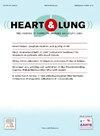Acute decompensated pulmonary hypertension outcomes in pulmonary arterial hypertension patients: systematic review and meta-analysis of proportions
IF 2.4
4区 医学
Q2 CARDIAC & CARDIOVASCULAR SYSTEMS
引用次数: 0
Abstract
Background
Acute decompensated pulmonary arterial hypertension (ADPH) is characterized by right heart failure due to elevated afterload and inadequate cardiac output, and it presents a significant mortality risk. Understanding mortality proportions and the impact of life-sustaining therapies is crucial for informing clinical practice and patient prognosis.
Objectives
To assess mortality proportions in ADPH across different clinical settings and to assess how they vary depending on the type of life-sustaining interventions used.
Methods
A systematic review and meta-analysis of proportions were conducted, examining mortality in ADPH focusing on three primary outcomes: ICU mortality, hospital mortality, and hospital mortality in patients requiring extracorporeal membrane oxygenation (ECMO). Common and random-effects meta-analyses were performed to calculate pooled mortality proportions with 95% confidence intervals (CI95%). Temporal trends were analyzed using meta-regression.
Results
Twenty-five observational studies conducted between 2003 and 2023, involving 1,249 ADPH patients, were included. The random-effect analysis revealed an ICU pooled mortality proportion of 29% (CI95% 25–34, I2=40%, p=0.12) and a pooled hospital mortality proportion of 38% (CI95% 31–47, I2=70%, p<0.01). Pooled mortality proportion for patients on ECMO was 45% (CI95% 38–52, I2=0%, p=0.96). Patients receiving inotropes or vasopressors had pooled mortality proportion of 56% (CI95% 44–68, I2=42%, p=0.18) and 57% (CI95% 48–65, I2=57%, p=0.02), respectively. Meta-regression analysis revealed no significant trend in hospital mortality over the span of twenty years.
Conclusions
Variation in ADPH mortality across hospital settings and life-sustaining therapies underscores the complexity of managing ADPH. These findings inform clinical practice and support prognostic discussions with patients and families.
肺动脉高压患者的急性失代偿肺动脉高压结局:系统回顾和比例荟萃分析。
背景:急性失代偿性肺动脉高压(ADPH)的特点是由于后负荷升高和心输出量不足导致右心衰竭,具有显著的死亡风险。了解死亡率比例和维持生命疗法的影响对于指导临床实践和患者预后至关重要:评估不同临床环境下 ADPH 的死亡率比例,并评估不同类型的维持生命干预措施对死亡率的影响:方法:对比例进行了系统性回顾和荟萃分析,研究了ADPH的死亡率,重点关注三个主要结果:重症监护室死亡率、住院死亡率以及需要体外膜肺氧合(ECMO)患者的住院死亡率。采用共同效应和随机效应荟萃分析法计算汇总死亡率比例及 95% 置信区间 (CI95%)。使用元回归分析了时间趋势:共纳入了 25 项在 2003 年至 2023 年间进行的观察性研究,涉及 1,249 名 ADPH 患者。随机效应分析结果显示,ICU汇总死亡率为29%(CI95% 25-34,I2=40%,P=0.12),医院汇总死亡率为38%(CI95% 31-47,I2=70%,P2=0%,P=0.96)。接受肌注或血管加压药的患者汇总死亡率分别为56%(CI95% 44-68,I2=42%,p=0.18)和57%(CI95% 48-65,I2=57%,p=0.02)。元回归分析显示,二十年间医院死亡率无明显趋势:不同医院环境和维持生命疗法下 ADPH 死亡率的差异凸显了 ADPH 管理的复杂性。这些研究结果为临床实践提供了参考,并为与患者和家属讨论预后提供了支持。
本文章由计算机程序翻译,如有差异,请以英文原文为准。
求助全文
约1分钟内获得全文
求助全文
来源期刊

Heart & Lung
医学-呼吸系统
CiteScore
4.60
自引率
3.60%
发文量
184
审稿时长
35 days
期刊介绍:
Heart & Lung: The Journal of Cardiopulmonary and Acute Care, the official publication of The American Association of Heart Failure Nurses, presents original, peer-reviewed articles on techniques, advances, investigations, and observations related to the care of patients with acute and critical illness and patients with chronic cardiac or pulmonary disorders.
The Journal''s acute care articles focus on the care of hospitalized patients, including those in the critical and acute care settings. Because most patients who are hospitalized in acute and critical care settings have chronic conditions, we are also interested in the chronically critically ill, the care of patients with chronic cardiopulmonary disorders, their rehabilitation, and disease prevention. The Journal''s heart failure articles focus on all aspects of the care of patients with this condition. Manuscripts that are relevant to populations across the human lifespan are welcome.
 求助内容:
求助内容: 应助结果提醒方式:
应助结果提醒方式:


